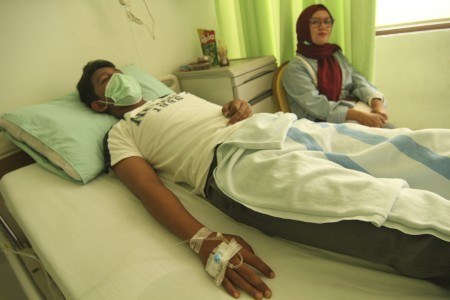Popular Reads
Top Results
Can't find what you're looking for?
View all search resultsPopular Reads
Top Results
Can't find what you're looking for?
View all search resultsHealth Ministry warns of spread of Hepatitis A in Greater Jakarta following outbreak in Depok
Change text size
Gift Premium Articles
to Anyone
T
he outbreak of hepatitis A affecting hundreds of residents of Depok in West Java may have spread to other areas, according to the Health Ministry, which has urged residents in its neighboring cities in Greater Jakarta to increase awareness about the potential of being affected.
The ministry’s disease control and prevention director general, Anung Sugihantono, said both the residents and the city administrations around Depok, especially in Jakarta; Bogor and Bekasi in West Java; and South Tangerang, Banten, should be aware of the spread of the virus.
The ministry has sent a letter to the health agencies in each area surrounding Depok as an early warning of the potential spread.
“We have also established an alert system in Bogor to be able to see and interpret the signs or symptoms from the community regarding cases of hepatitis A,” Anung said recently, as quoted by tempo.co.
He explained that the disease outbreak started from a school official at SMP 20 state junior high school in Depok as the first carrier. The school official happened to also be a seller of some food from which the virus was allegedly transmitted to the students and teachers.
As of now, Anung said, there had been 262 cases of hepatitis A in Depok reported to the ministry. The disease, which initially struck students and teachers in the school environment, has now spread to different areas in Depok.
Of the 262 cases, 228 were found at SMP 20, 31 were reported by residents near the school, five were found at a nearby Islamic boarding school and three were reported by family members of the students.
As the disease has spread in Depok, the ministry has raised concerns over the carriers’ mobility to other surrounding areas. These include the school official detected as the first carrier who lives in Bogor and might have transmitted the hepatitis A to outside the city.
According to the World Health Organization (WHO) hepatitis A is a viral liver disease that can cause mild to severe illness. The virus is transmitted through ingestion of contaminated food and water or through direct contact with an infectious person.
When symptoms occur around two to six weeks after infection, the carriers may show symptoms including nausea, vomiting, diarrhea and fever. The patients also often feel pain in the right upper abdomen, near the infected liver.
The symptoms can be more severe if the hepatitis A virus causes fulminant hepatitis with a risk of death. (syk)










